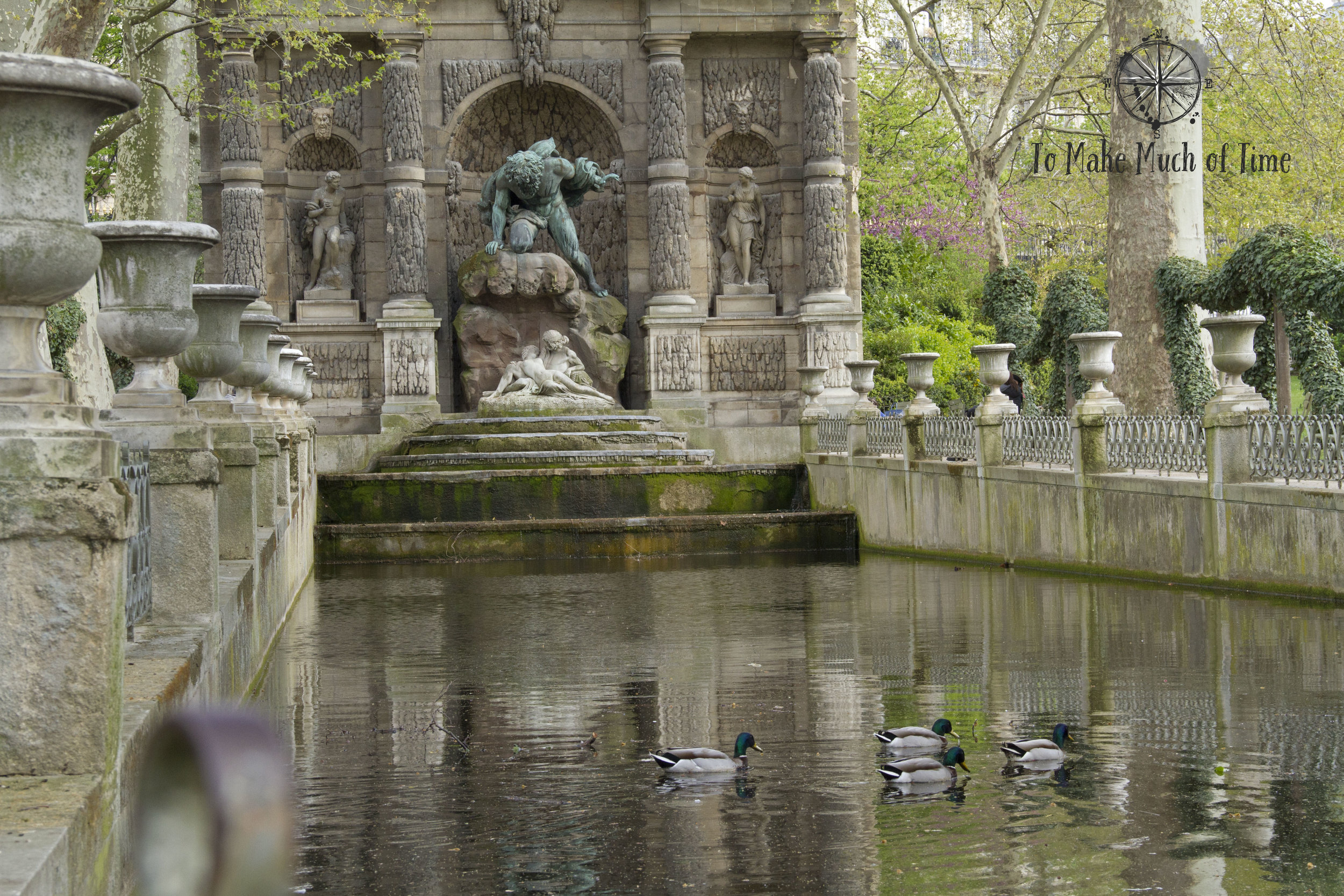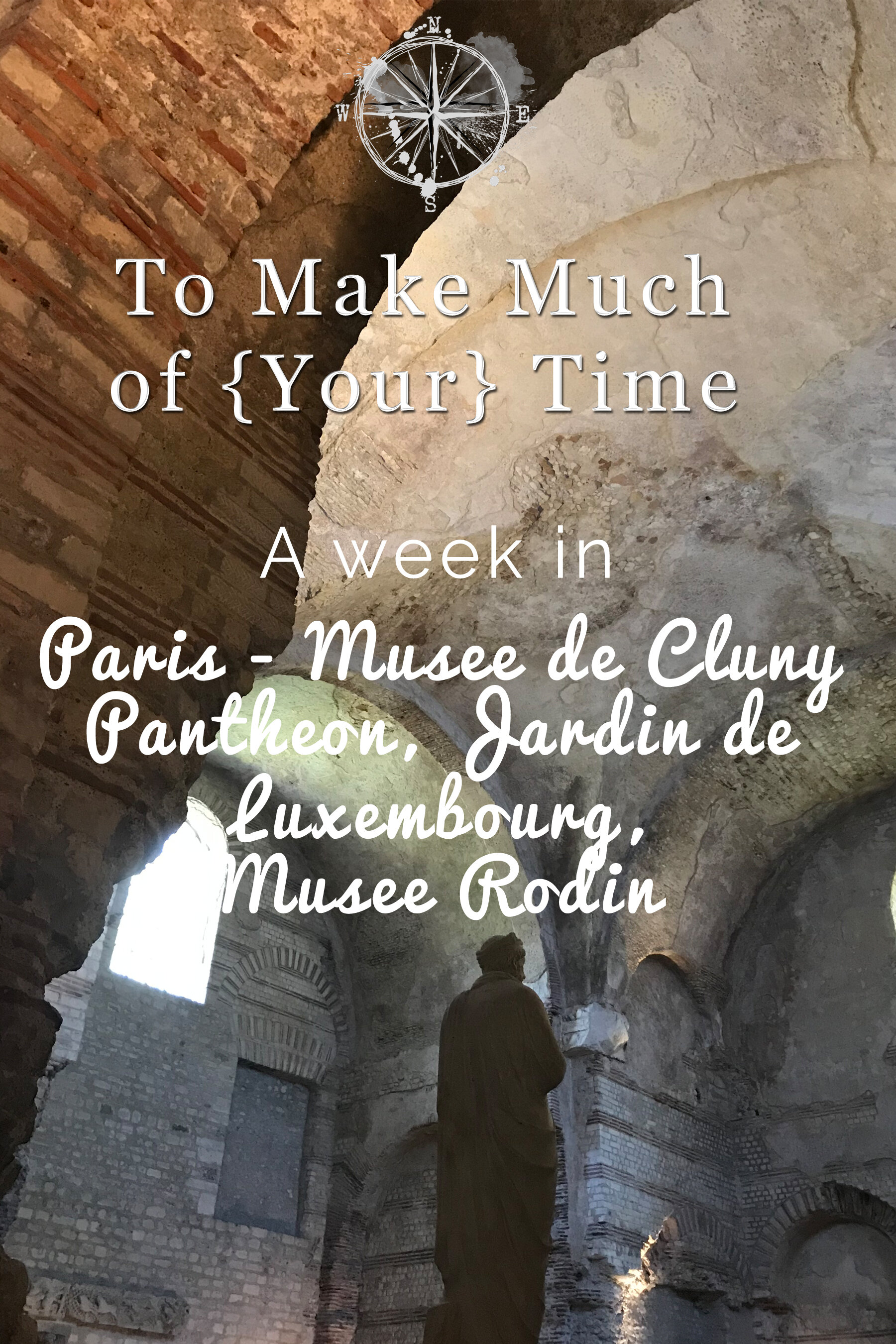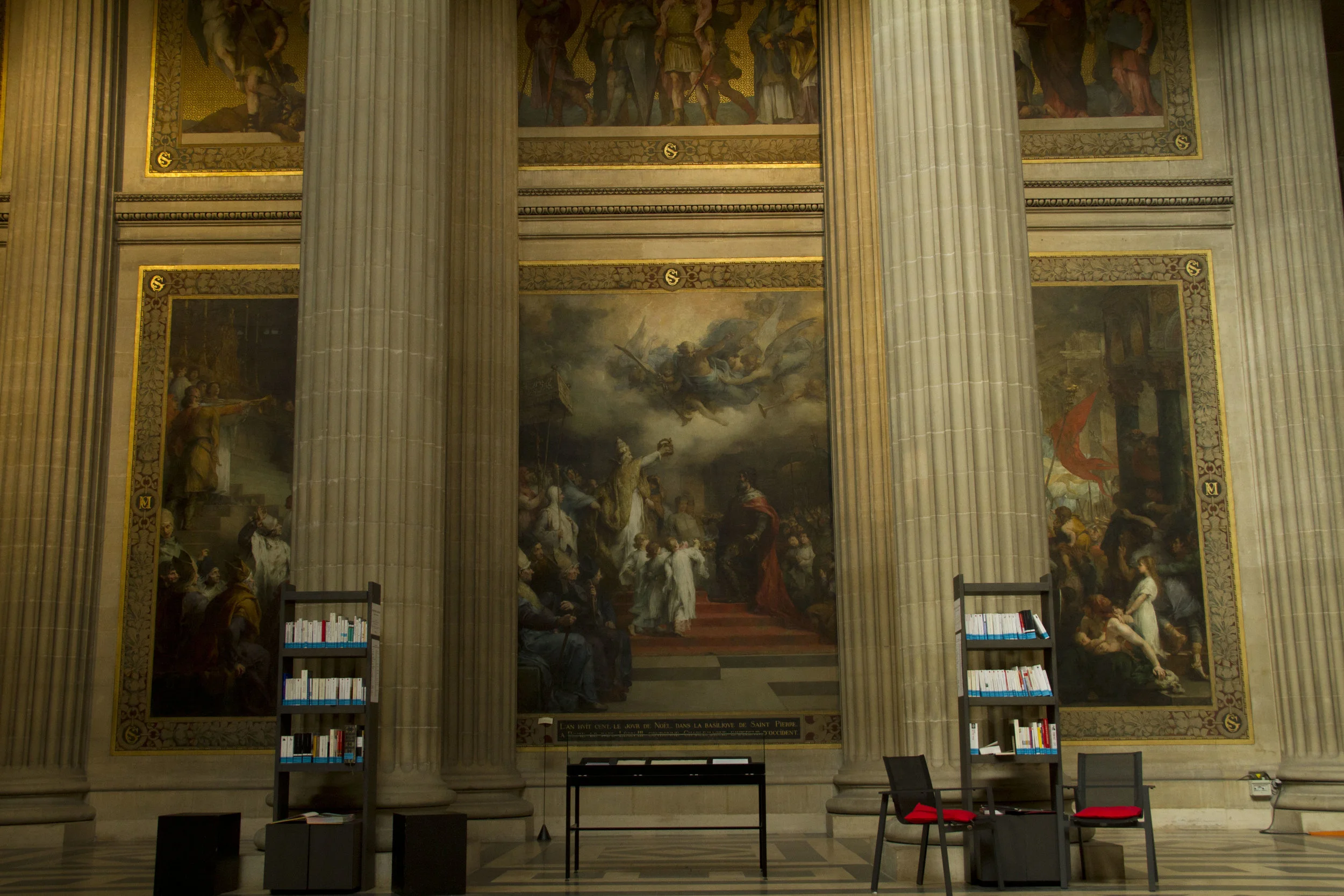Paris: A Week in the City of Love: Day 6 - Musée de Cluny, Pantheon, Jardin de Luxembourg, Musée Rodin
UPDATED: 10/14/2025
Note: Some links throughout our site are affiliate links, which means we may receive a small commission at no cost to you.
Booking a trip to Paris? Check out these great accommodation options available through VRBO! If you want to rent a bike or take a bike tour in Paris, check out Unlimited Biking here.
With different itineraries, we parted ways with our traveling companions for the day. The first stop on the list for us was Musée de Cluny, the National Museum of the Middle Ages. I have always been particularly fascinated by that time period and wanted to see the famous tapestry housed at this museum, the Lady and the Unicorn, that I had studied and fallen in love with in an art history class in college.
The museum itself is pretty small. We headed upstairs to the main exhibit and checked out the ante rooms before going in search of the tapestry. The exhibition during our visit was entitled The Five Senses: An Echo to the Lady and the Unicorn and provided a window into the way the senses were viewed during the Middle Ages, a topic that was entirely new to the two of us. We learned that all five senses were purposefully brought to play - for example, the incense during mass introduces the sense of smell.
This little garden along the side of the Cluny Museum is planted with things native to medieval France.
Within the oldest part of the building is the remains of an ancient Roman Bath which has been repurposed many times throughout the centuries.
Around the corner, we found ourselves in a tall, square room that housed not just the Lady and the Unicorn, but the rest of the set in the series! As much as I have always appreciated that tapestry, I had no idea (or had forgotten), that it is one of a series of six tapestries. No surprises that five of them represent each of the five senses and the last represents understanding, which is (supposedly) housed in the heart. Being in a room surrounded by these six massive tapestries left me in awe of the craftsmanship, artistry, painstaking detail, and amount of time that must have gone in to each of them and the more recent restoration. It also provided a sense of scale - for a home to be large enough to house these would be a very spectacular place indeed! Probably created in the early 1500s in Flanders for the Parisian le Viste family, they were eventually lost to time until they were rediscovered in 1841 in poor condition. In 1882 they were acquired by the museum, restored, and look to be in very good condition today.
For those who enjoy reading novels based upon works of art, Tracy Chevalier brought a fictionalized backstory to the The Lady and The Unicorn in her book by the same title. I read the book years ago and remember enjoying it. As a side note: this is the same author who wrote Girl with a Pearl Earring about a Vermeer painting, which was later turned into a movie.
After taking these tapestries in and fantasizing about living in a home where I could hang enormous tapestries - though I think I will hold off a little longer until houses are self-cleaning - we headed back through another room filled with artifacts of the Middle Ages. Reliquaries, golden statues, and other artistic works, often for religious purposes, filled the room. Because this museum is far less popular than some of the big-name museums dotting Paris, we had very few visitors to contend with and could take our time exploring and reading about the objects.
It amazes me how old the base structure of this Roman Frigidarium is!
Downstairs, I was ready to head for the exit. Dustin had spotted a sign on the wall pointing to the Frigidarium. It didn’t look to be part of the exhibit and, I admit, I was probably turned off by the word as someone who is always cold. But fine, I followed Dustin, expecting a dead end and a good ‘ole fashioned I-told-you-so.
But no, I was wrong, and I am so very glad!
In the semi-basement of the museum are the remains of a Roman bath! Built around the 1st century and in operation until the 3rd century, these are thought to be the largest ancient remains in Northern Europe today, and we found the space to be quite well preserved. The word frigidarium comes from the first “cold room” of a Roman bath house that proceeded the warmer rooms. As if in a soaring cathedral, the vaulted ceiling is about 45 feet high. It appeared that off-limits to visitors were some rooms below that were part of the warmer rooms (had I been alive at the time, you would have found me there), and from a sign that was in poorly-translated English, it seemed that tickets may be available on occasion for below-ground tours.
Housed in the frigidarium is a notable work of history. The Pillar of the Boatmen, carved out of limestone from around the year 25 AD, are thought to be the oldest monument in Paris and one of the earliest Gallo-Roman works of art to include inscriptions. Featuring Roman gods and Latin inscriptions, the belief that they were stacked into pillars is not confirmed and no one is sure exactly how they were structured. At some point, the pillars, which represented a guild of sailors in the city, were moved from their original home to a spot to reinforce walls on Île de la Cité where they were rediscovered in the early 1700s during work on Notre Dame. For more on the fascinating excavations on Île de la Cité, check out our next blog. In total, we spent just about an hour at Cluny and would definitely recommend it for those interested in the Middle Ages or in Roman history.
I’d forgotten how BIG the doors to the Pantheon were! Lindsey looks so tiny in comparison.
The detail on the ceiling adds to the grandiose and inspiring feel of the Pantheon.
Books written by those entombed below can be found in this small library located within the Pantheon.
Lindsey feeling very small under the dome of the Pantheon in Paris.
Always remember to look down while in Paris. Often the floors are just as interesting as paintings on the walls.
From the columns to the ceiling and floors, everything at the Pantheon is decorated and embellished.
While the Pantheon is currently a secular, state-owned mausoleum, it began life as a cathedral. To look at the building from the outside, it appears to fit in the milieu of Neoclassic state capitol buildings in the United States. The interior was magnificent, in spite of some repair work being in progress. On the main floor where you enter, there were large sculptures and statues and frescoes on the walls that were interesting to explore. There was a miniature library with seats for readers that contained the works of the writers buried in the crypt.
Victor Hugo, Alexandre Dumas, and Emile Zola share a room below Paris’ Pantheon.
In the back of the building were stairs that descended into the crypt below. The crypt was a very cool space - both architecturally and in temperature. The first space included the burial spots of people such as Voltaire, who has his own tall statue to accompany it. There is an interesting story that you can read about in this Atlas Obscura article but suffice it to say that neither Voltaire’s brain nor heart are entombed here with him. His heart can be visited in the National Library in Paris if you are so inclined.
After this first room was a bit of an underground rotunda from which different passageways veered off. Within each were a few hallways that had small burial rooms that could house several people of national notoriety. Some of the most famous people buried here are Rousseau, Hugo, Zola, Descartes, Braille, Dumas, Saint-Exupéry, Pierre Curie, and his wife and the first woman to be buried here, Marie Curie. The crypt is still used to this day with recent burials in 2018. From what we could tell, there is a lot of room left, so aspiring young French thinkers and writers, one of these spots could be yours someday!
Voltaire holds a position of particular honor in the crypts below the Pantheon.
There is nothing like time spent underground in burial chambers to work up an appetite, in the purview of the living. We didn’t have to go far before finding La Creperie just down the street. The food here was amazing and the servers were very nice. We ate in an area that was basically a sun room with little bistro tables crowded in. We were able to do a little people watching on the nearby street and saw our first (and last) ever Make America Great Again hat. Funny that we have never seen one in the US (and we live in a conservative part of the state of Virginia) but did in France.
The day was chilly but the sun was at least out and warm, so we walked to Jardin de Luxembourg. The Luxembourg Palace was built by Marie d’Medici and today houses the French senate. Open to the public behind it remains the vast gardens. One side of the property is a French garden, the other is an English garden, and there is an avenue and pond separating the two. With sculptures around the pond and plenty of places to sit on a nice day, the highlight for us was the Medici Fountain.
I feel like a broken record saying this, but had the weather been maybe 10 degrees warmer, we would have spent more time here. As it was, we spent maybe 30 minutes wandering through the garden before heading to our next spot, which was indoors - Musée Rodin.
“Walk faster I’m cold!” Lindsey said. I felt a little guilty but I’m glad I snapped a few shots while we walked because I really like this one!
Lindsey was so happy to step in out of the cold and grab a nice warm drink!
The museum is housed in the stately Hôtel Biron, where Rodin lived and worked. What is obvious in touring this museum is how very prolific Rodin was and the variety of materials he used to craft his sculptures. Because of the nature of sculpture making and casting, it was also evident how his work progressed with trial and error and over time. The beautiful garden surrounding the museum is a continuation of the collection with sculptures throughout the front and back gardens. What I will say is that it was a lot of Rodin to take in all at once. If you are not a huge fan of sculpture, this may not be the best stop for you. In the back garden is a small cafe where we had an afternoon snack.
As I looked at this I wondered if the folks at Lucas Films had seen this sculpture before creating the Han Solo frozen in carbonite seen in Star Wars. It does bear a striking resemblance.
Musee Rodin houses a large collection of sculptures, drawings, and photography.
Le Pensevr - The Thinker is a neat sculpture with a fascinating origin story. Read more about it here
I love this massive (20 foot tall) bronze sculpture of the Gates of Hell. You can see a small version of The Thinker perched above the gates. Read more about this sculpture here
Our next plan was to check out Musée d'Orsay, which came with strong recommendations to us. If it feels like we are cramming a lot into the day, that is because d’Orsay is open late on Thursdays and can be a good way to visit with fewer people there. Unfortunately, when we arrived, we discovered it had closed early for a special event and so we were unable to visit. I guess the lesson there is if there is something you have to see, make sure you check any last-minute closings or go earlier in your trip. Next time we make it back to Paris, d’Orsay will be on our list. The way we did experience it though was walking its length along the street back to our apartment. The museum, a former railway station, went on and on and on!
From what appears to be the entrance of Le Coupe Chou, follow the signs around to the right and look for the small unassuming door that brings you into this wonderful restaurant.
Warm wood tones and lighting give a welcoming and comfortable feel to dining at Le Coupe Chou. Can we move in??
For dinner, we went to a spot just a few blocks from where we were staying and one that had been recommended by the my in-law’s father, who had lived in Paris and visited many times. Le Coupe Chou had delicious food and the most original restaurant space I think I have ever eaten in. The building was built in the 17th century as a townhouse. The rooms were small and intimate, ours had an old fireplace, the lighting was dim as if lit by candles entirely, and each space and room that we passed on the way to our table looked like its own quaint space with visible ceiling beams and stone walls throughout.
The restaurant has some interior photos of their space on their site that you can view here. Dustin ordered a trout fillet with almonds, zucchini, and peas, and I had a sea bream fillet with mango butter on fennel bed (sea bream is a type of fish that was new to me). For dessert, we had the amazing Chocolate Liégeois (similar to chocolate mousse). Our in-laws loved this place so much that they actually returned the following night while we tried somewhere new.
The following day we finally visited Notre Dame, which we had walked past so many times, and found the easily overlooked, hidden in plain sight crypte archéologique de l'île de la Cité. Keep reading: click here to read about day 7.
Booking a trip to Paris? Check out these great accommodation options available through VRBO! If you want to rent a bike or take a bike tour in Paris, check out Unlimited Biking here.
Click the image below to save this post to Pinterest!
Check out our other posts about France:
Scale the heights of Notre-Dame…
And the depths of Crypte archéologique below the ground.















